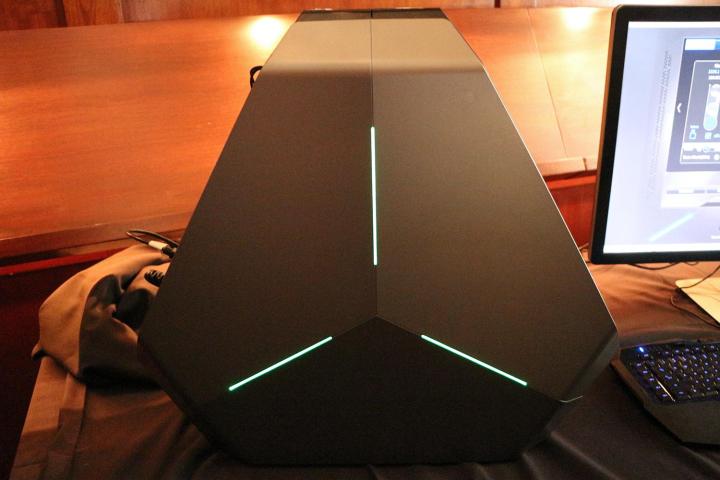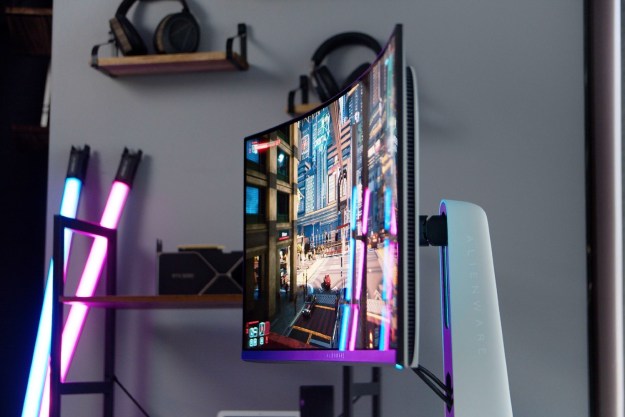The otherworldly Alienware Area 51 combines eye-grabbing looks with practical design, and supremely powerful hardware options.
Alienware has long been known as a top-tier maker of gaming PCs. However, others like Digital Storm, Origin PC and Cyberpower offer stiff competition in this space. So, these companies have to keep one-upping each other in order to attract gamers to their gear. After all, hardcore PC gamers and enthusiasts, unlike most average consumers, are actually willing to spend big bucks on elite hardware, if Amazon’s best selling desktop PCs page is any indication.
In the company’s latest attempt to sway potential buyers over to their side, Alienware has revamped, re-tooled, and re-launched its Area 51 desktop gaming PC. The Area 51 line goes back to the 1990s, and if this latest version can do one thing, its grab your attention and make you go “Whoa, what’s that?” Plus, it lands right alongside the Core i7-5960X, the Intel’s first 8-core CPU for consumers.
Related: Intel Core i7-5960X 8-core CPU review
In a posh backroom section of a hotel in the heart of New York City, we got the world’s first look at the new Area 51. Though Alienware set the Area 51 down in a place where you’d expect The Most Interesting Man in the World to be smoking Cuban cigars and regaling a crowd with tales of him fighting grizzlies with his bare hands (and winning), this was where we got our first peek at the company’s latest opus.
Here’s what we think of the new Alienware Area 51, and what you should know.
The ship has landed
Though Alienware has carried the Area 51 line for about 15 years, this is the closest it has ever come to truly looking like a spacecraft. The Area 51′s shape is best described as a cross between a triangle and a rhombus, and instead of wearing a typical rectangular-like design, both the front and rear panels are slanted upward, supplemented by multiple corner points. The green lights (which can be switched to different colors) along the case’s front and sides, combined with the flying saucer-like case design, grant the Area 51 a mysterious aura, and remind us of grainy UFO sighting photos we’ve seen in supermarket tabloids.
Though Alienware has carried the Area 51 line for about 15 years, this is the closest it has ever come to truly looking like a spacecraft.
In other words, if Fox Mulder from the X-Files saw the new Alienware Area 51, he might freak out, have a panic attack, and start screaming “THEY’RE HERE!!!”
The front panel consists of an array of vertical bars with air vents in between them. On it sits the slot-loading optical drive, a pair of USB ports, audio/mic jacks, an SD card reader, and the power button, which lights up, and takes the shape of the Alienware alien insignia.
Alienware didn’t slant the front and rear panels upward just for looks though. We asked an Alienware rep why, aside from the wow factor, they chose to orient the case this way, and we got a pretty practical reason. Though PCs like these are of course called desktops, no one really keeps systems these large on their desks; they’re usually floor-bound. So, Alienware oriented the case’s front and rear panels upward so that users could have easier access to ports and other controls, keeping them from having to get off their chairs and/or bend down lower.
That sounds great, but do we wish the front-based USB and audio ports, along with the card reader, sat a little higher up on the case. The more towards the top they’d sit, the easier it would be to access them, generally speaking. The power button and the optical drive, however, are placed at good heights.
It’s worth noting that factors like user and chair height will also determine whether these are placed in good spots, and so the opinions will likely vary between shorter to taller users. Either way, we like what Alienware did here.
A trio of vertical lines that light up green are perched on the left side of the case, and are oriented in a Mercedes Benz-like star pattern. Each of the system’s corners have a pair of handles for you to grab onto. When we grabbed onto and lifted the Area 51, we found it to be as easy as possible to hoist a system of this size (over 40 pounds in this configuration). Though the handles are made of plastic, we shook the Area 51 quite a bit to test out their durability, and none of them bended noticeably.
We like the fact that Alienware allows users to carry the new Area 51 in multiple ways. Some may prefer to grab onto the two handles that are closest together, while others may prefer to keep their arms and hands wider apart. Considering this system’s heft, the multitude of carrying handles make transporting the Area 51 as easy as it could be. Top-mounted handles wouldn’t be very uncomfortable to use, and would place all of the strain on one arm/shoulder.
Around back, you’ll find a typical array of ports, consisting of eight USB 3.0, Ethernet, S/PDIF, standard audio jacks, and the video ports that come with whatever graphics cards you opt to stuff in your Area 51. This version had six DVI, three DisplayPort, and three HDMI, courtesy of its triple Nvidia GTX graphics card setup. This roster of ports is sufficient, but they’ll vary depending on what motherboard and
Speaking of the rear ports, Alienware added one small but welcome feature to the back panel: a pair of white lights that sit directly to the left of the USB ports. The average PC gamer is a creature of the night, and the lights make it easier to see and plug stuff into the connections on the Area 51′s back panel without having to flip on a large lamp to see where you’re going.
Dissecting the alien
We love the out-of-this-world case design, but we couldn’t help but wonder whether it would hinder or help out when it came time for internal upgrades and tweaks. We popped open the left panel, and took a look at the Area 51′s guts to find out.
One of the first things we noticed was that there’s little room between the power supply and the space above the graphics cards. Also, there’s nowhere to push the PSU forward either; the space is blocked by the Area 51′s bottom panel. So, in order to remove the power supply, you’ll have to slide it out from the back of the system.

Fortunately, the system’s four memory slots aren’t all stuck together. A pair are placed on each side of the CPU socket, but that could change if you opt for a different motherboard, of course. To save space, Alienware decided to place the system’s hard drives on the inside of the Area 51′s right panel, underneath the motherboard. This makes swapping them in and out much easier, and we’re glad that Alienware didn’t try to cram everything into the left side. This gives you more room to work, and could lead to improved airflow.
Alienware will let you stuff the new Area 51 with all manner of uber-powerful PC hardware, including Intel’s newest monster: the Core i7-5960X. This is the company’s first 8-core processor for consumer desktops. Of course, you’ll be able to downgrade to lesser Core i7s and i5s. However, if you want the highest of the high-end, it’ll be available on the CPU front, which takes us to the graphics card side of the aisle.
When we spoke with Alienware, we asked whether buyers will be able to outfit the Area 51 with AMD’s Radeon R9 295×2 dual-GPU graphics card, and the answer is no. You’ll be able to stuff Nvidia GeForce GTX Titan Z cards in it, and while the Titan Z is a supremely powerful card, the 295×2 is even better. Plus, most importantly, the 295×2 costs $1,500, while the Titan Z is double that ($3,000).
You could, of course, configure the Area 51 with a trio of GeForce GTX 780Tis and call it a day, but we wish that all of the best options were available. One 780Ti costs around $700, so multiply that by three, and you’re saving about $900 over the cost of a Titan Z while still getting extremely high performance.
Related: AMD Radeon R9 295×2 review
The unit we played with, as you can see in the photos above, was packing a trio of GeForce GTX graphics cards from Nvidia, along with an Intel Core CPU. We couldn’t get an exact number on how much an Area 51 like that would cost, but Alienware did imply that a system with that load-out would cost close to $5,000. To us, that sounds about right.
Impressions and conclusion
The new Alienware Area 51 looks like it could be the best entry in this series yet, and sets itself apart from the rest of the field as well.. The space craft-like design is eye-popping, the upward-slanted front and rear panels were designed with practicality in mind, and the built-in handles all over the system make it as easy to carry around as possible. Then, of course, are the component configuration options, which you can load up to make this system really fly, assuming you have the cash.
However, we do wonder how easy it would be to work on a system like this. Sure, the upgrade options will no doubt be plentiful with most configurations, but the cramped space around the power supply give us some slight pause in that department. However, we won’t get a full handle on how all that shakes out until we get a review unit in.
Overall, color us impressed. We look forward to reviewing the new Alienware Area 51, which will no doubt light up our benchmarks, make heads turn, and possibly scare our pets away.
Highs
- UFO-like aesthetics
- Super-powerful and customizable specs
- Sensible design choices
Lows
- No AMD Radeon R9 295X2 available for config
- Heavy
- Innards look somewhat cramped around power supply
- Likely expensive as configured
Editors' Recommendations
- Best gaming PC deals: Lenovo Legion, ASUS ROG, Acer Predator
- Buying a gaming laptop? These are the brands to trust
- The best mechanical keyboards you can buy
- This is a first for Alienware gaming laptops
- The 6 best PC cases in 2024








